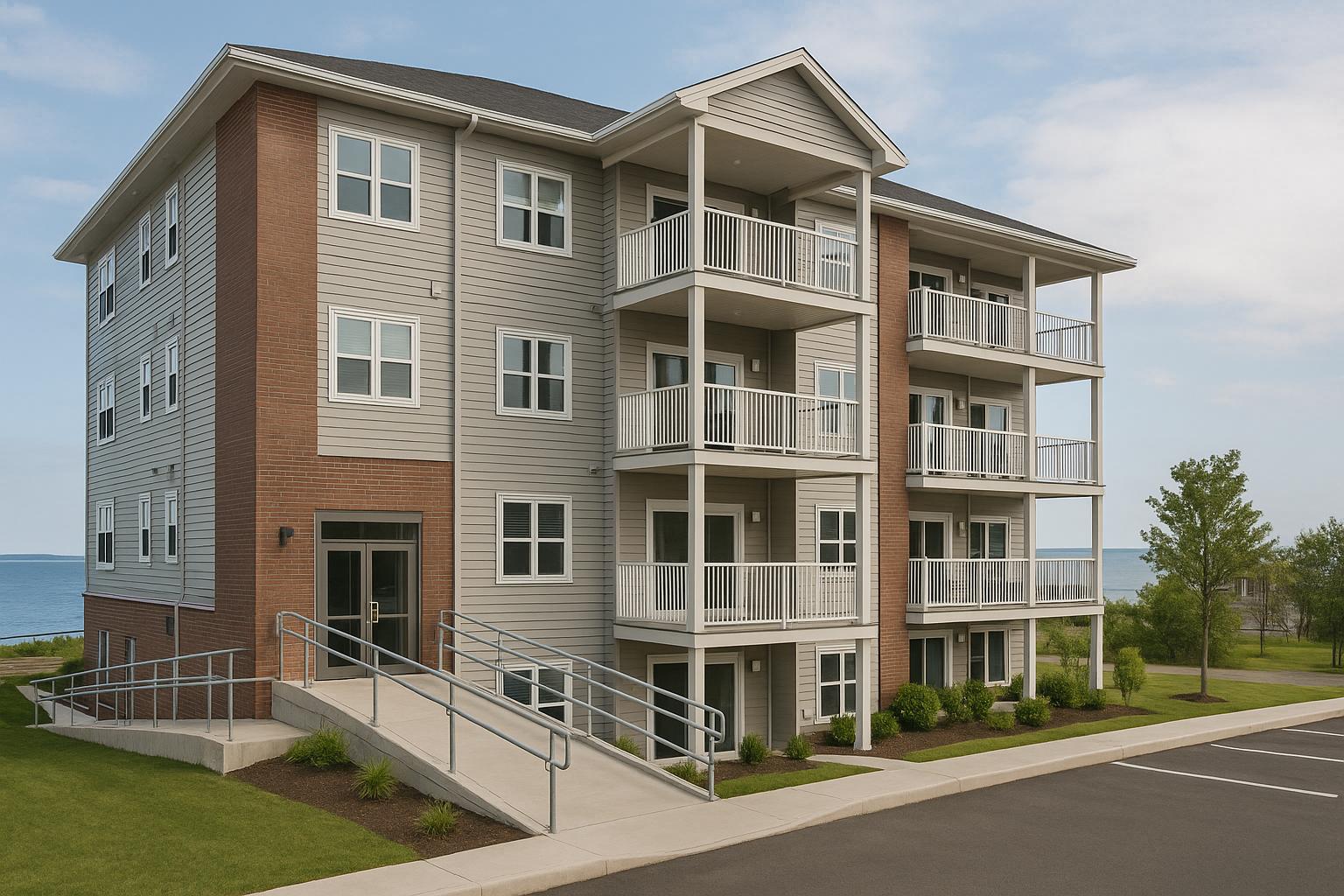Halifax is a growing hotspot for rental property development, thanks to a rising population, strong rental demand, and government incentives. With over 500,000 residents as of 2024, the city offers low vacancy rates, steady rental income, and an economy supported by diverse industries like healthcare, education, and technology. Key highlights for developers include:
- Rental Potential: Two-bedroom units fetch $1,950–$2,100 monthly, with demand driven by young professionals and a limited housing supply.
- ROI: Multi-unit properties can yield annual returns of 12–20%, supported by government incentives like tax breaks on purpose-built rentals.
- Zoning: Halifax’s zoning laws, including density bonuses, allow flexibility for multi-unit projects, especially in urban areas.
- Construction Tips: Opt for integrated design-build methods and fixed-price contracts to avoid delays and cost overruns.
- Financing: Programs like CMHC’s MLI Select offer up to 95% financing with a 50-year amortization, improving cash flow.
Whether you're planning a downtown project or exploring nearby towns like Bridgewater, Halifax offers strong opportunities for real estate investors.
Halifax Announces Special Planning Areas for New Housing Developments
Zoning Rules and Building Permits in Halifax
If you're planning a multi-unit development in Halifax, getting familiar with the city's zoning laws and permit process is a must. The Halifax Regional Municipality (HRM) lays out clear rules about what can be built and where, along with the steps to secure the necessary approvals.
Halifax Zoning Laws for Multi-Unit Buildings
Halifax is divided into zones, each with its own development rules. For instance, residential zones like R-2 (General Residential) are generally reserved for smaller multi-unit projects, while areas designated for multiple-unit dwellings allow for larger developments. In the urban core, governed by the Centre Plan, the emphasis shifts from traditional zoning restrictions to focusing on building design and form. In some cases, multi-unit developments are even permitted "by right", meaning fewer hurdles to clear.
In certain zones, developers can take advantage of density bonus programs. These allow projects to exceed standard density limits in exchange for providing community benefits, such as affordable housing. Parking requirements also vary depending on the zone - urban areas often have more relaxed parking rules compared to suburban ones. These zoning specifics not only help you determine where your project fits into Halifax's urban landscape but also set the groundwork for navigating the permit process.
How to Get Building Permits
Zoning rules don’t just influence where you can build; they also affect your budget and timeline. To secure a building permit, you'll need to submit detailed plans, including architectural, structural, and engineering designs. A site plan review is also required, covering elements like streetscape integration, parking layout, landscaping, and service access.
For larger multi-unit projects, you may need to enter into a development agreement with local authorities. This agreement outlines specific design and construction requirements. Permit fees are typically based on your project's construction value, so it's important to include them in your budget as they scale with the size and complexity of the development.
Additionally, Halifax often requires a Professional Engineer to certify the structural integrity of the building. Don’t forget to apply early for utility connections - such as water, electricity, and gas - to avoid delays once construction is underway.
Building Code Requirements
Nova Scotia follows the National Building Code of Canada, with local adaptations, to ensure construction meets essential safety and performance standards. Adhering to these regulations is crucial for a smooth approval process and long-term success.
Key requirements include fire separation measures between units and in common areas, energy efficiency standards for insulation, and accessibility features like barrier-free entrances. Proper ventilation is another must - each unit needs a system, whether natural or mechanical, to maintain good indoor air quality.
Inspectors will check your project at various stages, from laying the foundation to final occupancy, to ensure all safety and performance standards are met. By preparing for these requirements early, you can avoid unnecessary delays and complications. These regulations also play a role in choosing the best construction methods, which will be explored in the next section.
Once you've navigated zoning and permitting challenges, the construction method you choose becomes the next big decision. It’s a crucial factor that directly impacts both your budget and the timeline of your project.
Choosing the Right Construction Approach
The way you approach construction can dramatically influence the success of your multi-unit development in Halifax. Opting for separate contractors might stretch an 8-month project into a frustrating 18-month ordeal. Here’s why your choice matters.
Traditional Construction vs. Integrated Design-Build
In the traditional construction model, you hire individual professionals - a separate architect, structural engineer, mechanical engineer, general contractor, and subcontractors. While this might seem like a way to handpick the best talent, it often results in poor coordination.
For example, an architect’s design might clash with a structural engineer’s requirements, leading to costly mid-project revisions. Meanwhile, the general contractor could blame delays on incomplete drawings, while the engineer points fingers at design flaws. This cycle of miscommunication can drive up costs and delay completion, leaving you with no single point of accountability.
By contrast, integrated design-build takes a more collaborative approach. It unites planners, architects, engineers, and construction teams under one umbrella, ensuring that everyone works toward the same goal. This method eliminates the coordination headaches of traditional construction because the entire team shares accountability.
In Nova Scotia, companies like Helio Urban Development have successfully implemented this integrated approach. By involving design and construction teams from the outset, they’ve streamlined processes that traditionally lead to inefficiencies and waste.
Fixed-Price vs. Cost-Plus Contracts
The type of contract you choose can also make or break your budget. Cost-plus contracts, for instance, often lead to unpleasant surprises. Since the builder is reimbursed for costs plus a fee, there’s little incentive to keep expenses in check. It’s not uncommon to see overruns of 30-60% above the initial estimate.
On the other hand, fixed-price contracts provide financial certainty. These contracts lock in costs before construction begins, shielding you from unexpected price hikes or unforeseen challenges. With fixed pricing, any overruns are absorbed by the builder, not you.
For multi-unit developments, this difference is huge. Imagine a 4-unit building with a budget of $640,000. A 30% overrun under a cost-plus contract would add $192,000 to your expenses - potentially wiping out your first year’s rental income and severely cutting into your return on investment (ROI).
Some Halifax builders now offer fixed-price contracts with penalties for exceeding the agreed amount. This approach not only provides cost certainty but also ensures that builders stay motivated to deliver on budget.
Common Construction Problems and Solutions
Even with the right contract, construction projects can face delays and disputes. Miscommunication between trades can push timelines further, and contractors often shift blame rather than resolve issues. As the property owner, you could find yourself stuck in the middle, trying to mediate instead of watching your project come to life.
The solution lies in systematic delivery methods that prevent these problems before they occur. Advanced scheduling systems, for instance, ensure that trades and materials arrive precisely when needed. Some builders even guarantee their timelines, offering penalties of up to $1,000 per day for delays. This level of commitment is only possible when a single builder controls the entire process, rather than relying on multiple contractors to coordinate themselves.
Quality control is another critical area where integrated approaches shine. Instead of hoping each contractor meets standards, systematic builders enforce rigorous checks throughout the project. This might include inspections by a Professional Engineer at multiple stages of construction, with an option for property owners to bring in their own inspector for the final review.
Ultimately, the goal is to move away from the uncertainty of traditional construction. Seek out builders who offer systematic delivery, guaranteed timelines, fixed pricing, and clear accountability. These elements can transform your construction experience, giving you confidence that your project will be completed on time, within budget, and to the highest standards.
sbb-itb-16b8a48
Step-by-Step Guide to Building Multi-Unit Properties
Creating a successful multi-unit rental property in Halifax requires careful planning and efficient scheduling at every stage. Here's how to approach it effectively.
Site Selection and Feasibility Analysis
Start by evaluating potential sites to ensure they meet zoning requirements and have the necessary infrastructure. This step is crucial to identify any site-specific challenges early, helping you avoid delays and unexpected costs. A thorough feasibility analysis lays the groundwork for a smooth transition to the next phase - selecting the right builder.
How to Select the Right Builder
When choosing a builder, prioritize those with solid experience in multi-unit projects. Look for professionals who use an integrated design-build approach, as this often ensures better coordination and communication. A reliable builder will have a proven track record of managing planning, permitting, and construction efficiently. Don’t skip the step of checking references - this can confirm their ability to deliver projects on time and within budget.
Once you've selected a capable builder, the focus shifts to effective construction management to keep everything moving smoothly.
Construction Management Best Practices
Strong construction management is all about staying organized. Establish clear communication channels from the outset and schedule regular progress reviews to stay on top of developments. Incorporate frequent updates and quality checks to ensure the project stays on schedule and avoids unnecessary costs. These practices help maintain momentum and reduce the risk of delays.
Maximizing ROI on Your Halifax Multi-Unit Property
Once you’ve tackled the challenges of construction and permitting, the focus shifts to ensuring your investment delivers consistent returns. This involves smart design choices, strategic financing, and effective property management to keep your property performing well over the long term.
Energy Efficiency and Tenant Appeal
Investing in energy-efficient features is a win-win for property owners. Not only do they reduce operating costs, but they also attract tenants willing to pay competitive rents. Features like triple-pane windows and ductless heat pumps help lower heating expenses while making units more comfortable.
Adding smart home technology - such as keyless entry, programmable thermostats, and doorbell cameras - can also make your property stand out. These features, once considered luxuries, are now seen as necessities by many tenants. They can justify higher rents and encourage longer tenancy, reducing turnover.
Quality finishes are another way to enhance tenant appeal. Materials like quartz countertops and engineered hardwood flooring may require a higher upfront cost, but they tend to attract tenants who take better care of the property. This can lead to fewer vacancies and lower maintenance costs over time.
By optimizing your property’s appeal, you’re also positioning yourself for better financing opportunities.
Financing Options for Property Owners
The Canada Mortgage and Housing Corporation (CMHC) MLI Select program offers a unique opportunity for property owners to improve cash flow. This program provides up to 95% financing with a 50-year amortization period for energy-efficient multi-unit properties. The lower down payment - just 5% compared to the usual 20% - and extended amortization can significantly improve your financial leverage. For example, your leverage ratio can jump from 5:1 to 20:1, allowing you to build more units with the same amount of capital.
This financing structure can even make projects cash-flow positive from the start, thanks to reduced monthly payments.
If the CMHC program doesn’t suit your needs, conventional financing remains a solid option. While it typically requires a larger down payment, it can align better with projects that prioritize lower construction costs.
Property Management Tips
Effective property management is key to protecting your investment and maximizing long-term returns. Start with a proactive approach by establishing maintenance schedules before tenants move in. Focus on critical systems like HVAC, plumbing, and weatherproofing to prevent minor issues from turning into expensive repairs.
Tenant satisfaction plays a huge role in profitability. Quick responses to maintenance requests and open communication can reduce turnover and strengthen your reputation in Halifax’s rental market. Happy tenants are more likely to renew leases and recommend your property to others, cutting down on marketing costs.
Staying up to date with Nova Scotia’s residential tenancy regulations is also essential. Familiarize yourself with rules around rent increases, security deposits, and maintenance responsibilities to avoid disputes and protect your rental income.
Offering move-in ready units can further streamline operations. Including essential appliances and window coverings adds approximately $15,000 per unit to your initial investment but can eliminate delays in generating rental income. These fully equipped units often command premium rents and make the transition from construction to occupancy smoother.
As your portfolio grows, or if you live far from your properties, hiring a professional property management company can be a smart move. These companies typically charge a percentage of rental income and handle tasks like tenant screening, maintenance coordination, and compliance with regulations - allowing you to focus on expanding your investments.
Building Success in Halifax
Halifax’s multi-unit projects thrive when property owners avoid common pitfalls like fragmented coordination, budget overruns, and timeline delays. By recognizing these challenges and planning effectively, investors can achieve impressive returns.
One frequent mistake is attempting to juggle multiple independent contractors, architects, engineers, and planners. Many successful property owners instead choose an integrated team, where all the necessary experts work together under one roof. This approach not only minimizes inefficiencies but also ensures better control over budgets and project timelines.
Traditional cost-plus contracts often result in cost overruns of 30–60%. On top of that, delays can quickly add up - each month of delay can mean losing approximately $8,800 in rental income for a typical fourplex. A fixed-price construction model eliminates these uncertainties, giving you a clear understanding of your total investment upfront. By shortening construction timelines from the usual 12–18 months to just six months, you can start generating rental income much sooner.
Maintaining high-quality standards is another critical factor in protecting your long-term investment. A systematic approach to quality control, as discussed earlier, ensures your property remains valuable for years to come.
In addition to integrated methods and predictable costs, smart financing and strategic location choices are key to project success. Understanding your financing options before breaking ground is crucial. For instance, the CMHC MLI Select program can significantly increase your leverage - from 5:1 to 20:1. With 95% financing and a 50-year amortization period, projects often become cash-flow positive from the start, even with higher upfront construction expenses.
Location is equally important. Building within a 90-minute radius of Halifax expands opportunities beyond the city while maintaining access to skilled trades and reliable materials. Areas like Antigonish, Bridgewater, and other nearby towns offer strong rental demand paired with reasonable land costs - an excellent combination for investors.
Success in Halifax’s real estate market comes down to an integrated approach that combines fixed pricing, guaranteed timelines, and thorough quality control. These elements are essential for achieving annual ROIs of 12–20%. With the right builder and a well-thought-out strategy, you could join others earning between $1,950 and $2,100 in monthly rent per unit - laying the groundwork for long-term wealth through real estate.
FAQs
What are the advantages of using an integrated design-build approach for multi-unit rental projects in Halifax?
The integrated design-build approach merges the design and construction phases into one cohesive process, helping to cut down on delays and achieve quicker project completion. By encouraging early collaboration among architects, builders, and other professionals, this method simplifies workflows and reduces the likelihood of expensive change orders.
Another advantage is greater cost predictability. Budgets are set early on and fine-tuned through value engineering, giving property owners a clearer financial picture. With a single point of accountability, there's less stress and fewer uncertainties during the project. On top of that, this model often leads to superior designs and eco-friendly solutions, as teams work together from the outset to create buildings that are functional, efficient, and mindful of Halifax's distinct urban landscape.
How do Halifax's zoning laws and density bonus programs affect building multi-unit rental properties?
Halifax's zoning laws and density bonus programs play a crucial role in shaping the success of multi-unit rental projects. In high-demand areas like Downtown Halifax and the Regional Centre, density bonusing offers developers the chance to build higher-density projects in return for contributing public benefits, such as affordable housing or community amenities. This arrangement not only increases the potential for rental income but also enhances the overall feasibility of such developments.
On the other hand, suburban and rural areas often lack a well-structured density bonus system. This absence can restrict opportunities to add density, making projects in these locations less adaptable and potentially less profitable. For developers, navigating these zoning details is key to ensuring a project's viability in Halifax.
What are the best financing options for building multi-unit rental properties in Halifax, and how can they help improve ROI?
Developers in Halifax can tap into a variety of financing options designed to boost the return on investment for multi-unit rental properties. One standout choice is CMHC's multi-unit loans, which offer up to 95% financing. With a low down payment requirement and extended amortization periods - stretching up to 50 years - this program helps cut down upfront costs and makes repayments more manageable over time.
Another valuable resource is Nova Scotia's Community Housing Acquisition Program, which provides loans covering up to 95% of property costs. This initiative is tailored to support affordable housing projects, reducing the initial capital needed while offering longer repayment terms. These flexible financing options not only ease financial strain but also improve cash flow, making it easier for property owners to achieve long-term profitability.
Related Blog Posts
- Halifax & Area Development Guide: Opportunities in Underserved Communities
- Small Multi-Unit Development 101: Building Duplexes and Fourplexes in Nova Scotia
- Secondary Suites and Backyard Homes in Halifax: Adding Value with New Housing Options
- Federal Housing Fund Halifax: How Zoning Changes Unlock Development



